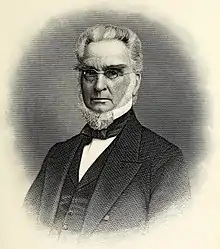Erastus Fairbanks | |
|---|---|
 | |
| 21st and 26th Governor of Vermont | |
| In office October 12, 1860 – October 11, 1861 | |
| Lieutenant | Levi Underwood |
| Preceded by | Hiland Hall |
| Succeeded by | Frederick Holbrook |
| In office October 1, 1852 – October 1, 1853 | |
| Lieutenant | William C. Kittredge |
| Preceded by | Charles K. Williams |
| Succeeded by | John S. Robinson |
| Member of the Vermont House of Representatives from St. Johnsbury | |
| In office 1836–1840 | |
| Preceded by | David Goss Jr. |
| Succeeded by | Lambert Hastings |
| Personal details | |
| Born | October 28, 1792 Brimfield, Massachusetts |
| Died | November 20, 1864 (aged 72) St. Johnsbury, Vermont |
| Political party | Whig (before 1855) Republican (from 1855) |
| Spouse | Lois Crossman |
| Relations | Thaddeus Fairbanks (brother) Ephraim Paddock (uncle) |
| Children | 9, including Horace Fairbanks and Franklin Fairbanks |
| Profession | Businessman |
| Signature | |
Erastus Fairbanks (October 28, 1792 – November 20, 1864) was an American manufacturer, Whig politician, a founder of the Republican Party, and the 21st and 26th governor of Vermont.
Biography
Fairbanks was born in Brimfield, Massachusetts, to Phebe (Paddock) Fairbanks (1760–1853) and Joseph Fairbanks (1763–1846). Ephraim Paddock, the brother of Phebe Paddock, was his uncle.[1] He studied law but abandoned it for mercantile pursuits,[2] and operated a store in Wheelock, Vermont. He married Lois Crossman (1792–1866) on May 30, 1815.[3] The couple had nine children.[4]
Career

Finally settling in St. Johnsbury, Vermont, in 1824, Fairbanks formed a partnership, E. & T. Fairbanks & Co., with his brother Thaddeus for the manufacture of scales, stoves and plows.[2] Thaddeus Fairbanks later invented the first platform scale, which made it possible to calculate the weight of farm products and other goods shipped by wagon and railroad car; the device proved so successful that the renamed Fairbanks Scales company became the largest employer in the state.
The Fairbanks family was involved in numerous charitable and civic endeavors throughout St. Johnsbury and the surrounding towns, including the 1842 founding of St. Johnsbury Academy.[5]
Fairbanks was a member of the Vermont House of Representatives from 1836 to 1840. He was a Whig Presidential Elector for Vermont in 1844 and 1848. He was President of the Passumpsic Railroad, which completed a line from White River to St. Johnsbury in 1850. Though he would ultimately withdraw from the venture due to disputes about labor and planning with the Boston Associates, Fairbanks and his company would be the first to fund the Hadley Falls Dam project in 1846. The project, conceived by one of his salesmen and personal associates, George C. Ewing, ultimately created Holyoke, Massachusetts.[6]
Fairbanks was elected the 21st Governor of Vermont in 1852 and served until 1853. During this term, a law was passed forbidding the sale or traffic of intoxicating beverages. The law was not repealed until 1902.[4]
Fairbanks was one of the founders of the Republican Party, and a delegate from Vermont to the first Republican National Convention in 1856. He was 26th Governor of Vermont from 1860 to 1861. During his second term he rendered valuable aid in the equipment and dispatch of troops in the early days of the American Civil War.[2]
Family life
With his brothers Thaddeus and Joseph P., he founded St. Johnsbury Academy. He was the father of Horace Fairbanks and Franklin Fairbanks.[3]
Death
Fairbanks was a Congregationalist. He died in St. Johnsbury, Caledonia County, Vermont, on November 20, 1864 (age 72 years, 23 days). He is interred at Mt. Pleasant Cemetery, St. Johnsbury, Vermont.
References
- ↑ Childs, Hamilton (1887). Gazetteer of Caledonia and Essex Counties, Vt. 1764-1887. Syracuse, NY: Syracuse Journal Company. p. 84.
- 1 2 3 Chisholm 1911.
- 1 2 "Erastus Fairbanks". The Political Graveyard. Retrieved November 7, 2012.
- 1 2 "Erastus Fairbanks". National Governors Association. Retrieved November 7, 2012.
- ↑ "Our History". stjacademy.org. St. Johnsbury, VT: St. Johnsbury Academy. Retrieved April 5, 2018.
- ↑ "Holyoke". History of the Connecticut Valley in Massachusetts, with illustrations and biographical sketches of some of its prominent men and pioneers. Vol. II. Philadelphia: Louis H. Everts; Press of J.B. Lippincott and Co. 1879. p. 917. OCLC 866692568.
In the autumn of 1846, George C. Ewing, of the firm Fairbanks & Co., of New York, began negotiations for the property at this point, which at the close of three months were finally and satisfactorily concluded, and the transfer of about 37 acres was made in March, 1847. Soon after, the property of the Hadley Falls Company, and the mills mentioned above, were also purchased by Mr. Ewing, and thus he succeeded in accomplishing what others had failed in. Mr. Ewing is still a resident of Holyoke, and may justly point with pride to the success of his mission, which added another flourishing city to the constellation that has rendered the commonwealth of Massachusetts famous both at home and abroad.
The first company was incorporated for the development of Fairbanks & Co., of which firm Mr. Ewing was a member, together with a number of Boston and Hartford capitalists... The Messrs. Fairbanks withdrew from the enterprise in January, 1848, when Mr. Ewing resigned
Further reading
- Fairbanks, Lorenzo Sayles, Genealogy of the Fairbanks Family in America 1633–1897, Boston, 1897.
External links
- Ancestry.com
- Fairbanks Museum in St. Johnsbury, Vermont
- The Political Graveyard
- National Governors Association
- Erastus Fairbanks at Find a Grave
- This article incorporates text from a publication now in the public domain: Chisholm, Hugh, ed. (1911). "Fairbanks, Erastus". Encyclopædia Britannica. Vol. 10 (11th ed.). Cambridge University Press. p. 130.
- Fairbanks family papers at Vermont Historical Society
